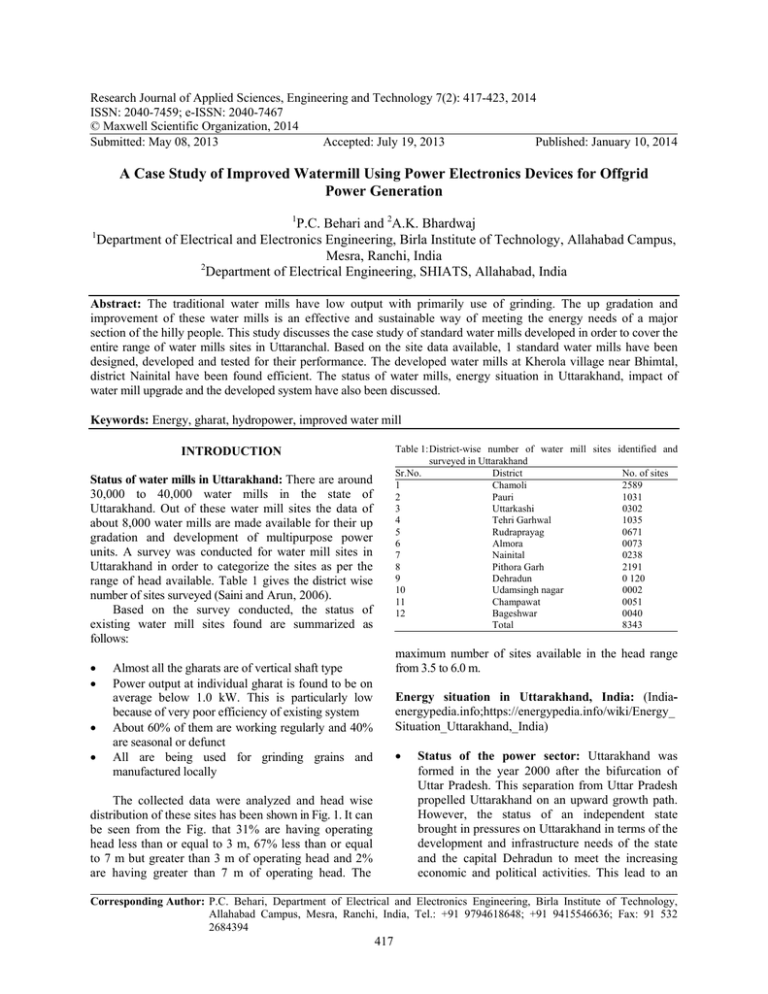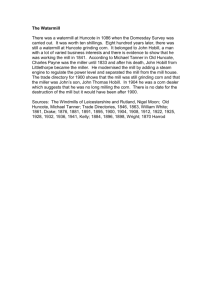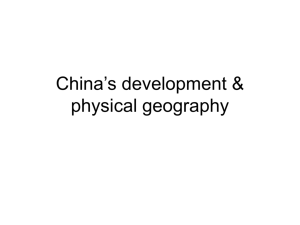Research Journal of Applied Sciences, Engineering and Technology 7(2): 417-423,... ISSN: 2040-7459; e-ISSN: 2040-7467
advertisement

Research Journal of Applied Sciences, Engineering and Technology 7(2): 417-423, 2014 ISSN: 2040-7459; e-ISSN: 2040-7467 © Maxwell Scientific Organization, 2014 Submitted: May 08, 2013 Accepted: July 19, 2013 Published: January 10, 2014 A Case Study of Improved Watermill Using Power Electronics Devices for Offgrid Power Generation 1 1 P.C. Behari and 2A.K. Bhardwaj Department of Electrical and Electronics Engineering, Birla Institute of Technology, Allahabad Campus, Mesra, Ranchi, India 2 Department of Electrical Engineering, SHIATS, Allahabad, India Abstract: The traditional water mills have low output with primarily use of grinding. The up gradation and improvement of these water mills is an effective and sustainable way of meeting the energy needs of a major section of the hilly people. This study discusses the case study of standard water mills developed in order to cover the entire range of water mills sites in Uttaranchal. Based on the site data available, 1 standard water mills have been designed, developed and tested for their performance. The developed water mills at Kherola village near Bhimtal, district Nainital have been found efficient. The status of water mills, energy situation in Uttarakhand, impact of water mill upgrade and the developed system have also been discussed. Keywords: Energy, gharat, hydropower, improved water mill Table 1: District-wise number of water mill sites identified and surveyed in Uttarakhand Sr.No. District No. of sites 1 Chamoli 2589 2 Pauri 1031 3 Uttarkashi 0302 4 Tehri Garhwal 1035 5 Rudraprayag 0671 6 Almora 0073 7 Nainital 0238 8 Pithora Garh 2191 9 Dehradun 0 120 10 Udamsingh nagar 0002 11 Champawat 0051 12 Bageshwar 0040 Total 8343 INTRODUCTION Status of water mills in Uttarakhand: There are around 30,000 to 40,000 water mills in the state of Uttarakhand. Out of these water mill sites the data of about 8,000 water mills are made available for their up gradation and development of multipurpose power units. A survey was conducted for water mill sites in Uttarakhand in order to categorize the sites as per the range of head available. Table 1 gives the district wise number of sites surveyed (Saini and Arun, 2006). Based on the survey conducted, the status of existing water mill sites found are summarized as follows: maximum number of sites available in the head range from 3.5 to 6.0 m. Almost all the gharats are of vertical shaft type Power output at individual gharat is found to be on average below 1.0 kW. This is particularly low because of very poor efficiency of existing system About 60% of them are working regularly and 40% are seasonal or defunct All are being used for grinding grains and manufactured locally Energy situation in Uttarakhand, India: (Indiaenergypedia.info;https://energypedia.info/wiki/Energy_ Situation_Uttarakhand,_India) The collected data were analyzed and head wise distribution of these sites has been shown in Fig. 1. It can be seen from the Fig. that 31% are having operating head less than or equal to 3 m, 67% less than or equal to 7 m but greater than 3 m of operating head and 2% are having greater than 7 m of operating head. The Status of the power sector: Uttarakhand was formed in the year 2000 after the bifurcation of Uttar Pradesh. This separation from Uttar Pradesh propelled Uttarakhand on an upward growth path. However, the status of an independent state brought in pressures on Uttarakhand in terms of the development and infrastructure needs of the state and the capital Dehradun to meet the increasing economic and political activities. This lead to an Corresponding Author: P.C. Behari, Department of Electrical and Electronics Engineering, Birla Institute of Technology, Allahabad Campus, Mesra, Ranchi, India, Tel.: +91 9794618648; +91 9415546636; Fax: 91 532 2684394 417 Res. J. Appl. Sci. Eng. Technol., 7(2): 417-423, 2014 Table 2: Installed capacity of Uttarakhand power utility (in MW) Total Installed capacity Thermal Nuclear 2453.74 330.61 22.28 RES: Renewable Energy Sources (includes: small hydro, biogas, biomass, waste and wind energy) Hydro 1956.18 RES* 144.67 Fig. 1: Head wise number of sites increase in the energy demand of the state too but the current power situation does not seem to be meeting it (Mittal et al., 2008). As per the Central Electricity Authority (CEA) (2006), the anticipated demand of the energy for Uttarakhand for the year 2011-12 is 10480 MU and the available energy is 8363 MU; while the peak demand of the state is 1600 MW and the availability is of 1430 MW. While Uttarakhand has certainly showed signs of growth in the last decade, the growth has not been a homogenous one. The growth process in Uttarakhand has been limited to the plain districts eluding the hilly areas, as most of the manufacturing units are located in the plain districts. 40% of the population of the state still lives below poverty line. Uttarakhand is a unique case of poverty as the state has a very low rate of unemployment and yet the incidence of poverty is very high. This hints towards the low wage and income rate in the state leading to a peculiar problem called 'a problem of the working poor’. Thus there is an ask for meeting the productive employment demands of the rural population in the state. This can be achieved through an efficient and reliable access to energy for the rural population. Also the development approaches are heavily dependent on the conventional energy sources that worked for the plains, might not prove much effective in the hills due to the associated difficult terrain. Energy capacity: RES: Renewable Energy Sources (includes: small hydro, biogas, biomass, waste and wind energy) Table 2 shows that a major part of total installed capacity is produced by Hydro (79.72%), Thermal (13. 47%), RES (5.9%) and 0.91% from Nuclearenergy sources. 418 Energy consumption: Energy, particularly, power consumption in the state of Uttarakhand has grown more than 5 times in the last eight years (20022010). Electricity consumption in the domestic sector of Uttarakhand has been quite substantial and higher than the country’s average, but over the years this proportion has shifted in favor of the industrial sector. In 2001-02 around 45% of the total electricity consumption was in the domestic sector which dropped to 29% by 2006-07. With the increasing demand from the industrial sector, in 2006-07 almost 40% of the total electricity consumption was by industries (Table 1). The share of electricity consumption for farming purposes has declined substantially from 14.4% in 2001-02 to 9.9% although the total actual electricity consumption has marginally increased. Res. J. Appl. Sci. Eng. Technol., 7(2): 417-423, 2014 Table 3: Electricity consumption by different sectors in Uttarakhand Sector 2001-02 2006-07 Domestic 44.7% 29% Commercial 11.4% 15% Industrial 21.4% 40.4% Agriculture 14.4% 9.9% Others* 8.2% 5.7% Total 2229.09 MW 3885.96 MW of this study is to provide insight required for the up gradation of water milling activity in Himalayan and sub-Himalayan region. Further, producing the optimum output of watermill for off-grid power generation and addition of UPS as well as alternator for production of uniform output voltage can be consider as the major objectives of this study. Table 4: Share of electricity of Uttarakhand: 8936 MU for 2009-10 State generation 4081 Central share 3391 Others 1464 MATERIALS AND METHODS Figure 2 shows the basic block diagram for power generation using water mill. Water is supplied from Pen stock and rotate the water turbine and in result mechanical energy is produced. This mechanical energy rotates the rotor of Electrical generator which generates unconditioned electric power. The output of generator is fed to UPS which gives stabilized power to control panel. Others include street lighting, water works and traction and railways. It can be deduced from the Table 3 that the percentage share of electricity consumption has increased only for commercial and industrial sectors. Since both the types of activities are usually concentrated in the urban settlements and industrial areas (plains in case of Uttarakhand), this tells us about the grim picture of the electricity consumption in the hilly rural areas Energy supply: As is evident from the Table 4, the state is able to meet only 52% of its power needs through its own resources. Although, currently, Uttarakhand is an exporter; it plans to become an importer of power in the coming years. Rural electrification: As per 1991 census, there are 15681 villages in the state of Uttarakhand. As of 31st march 2005, out of these 15681 villages, 13783 have been electrified which amounts to 85% of the total villages. Whereas, as per the 2001 census, 50.35% of rural households have been electrified. Around 96% of the rural villages in Uttarakhand are provided with electricity by Uttarakhand Power Corporation Ltd. UREDA, Micro-Hydel and Kuteer Jyoti connections are also prevalent but in less so in villages Objectives: This study presents an off-grid power generation method which will play a vital role in improving the performance of watermill which is widely used in hilly rural areas. The main objective This study presents a solution to power access for people in shecluded or remote places with the harnessing of energy from flowing water with a turbine and motor. The design and use of mechanical gears or acam system to funnel the flow of water will increase the RPM of motor. The UPS connected to elecrical generator supply and delivery a continuous duty, 50 Hz, 3kVA, 400V, three phase, (four-wire+earth) uninterruptible power supply system complete with maintenancefree sealed battery. For the electricity generation, lower grinding stone is fixed with the gap of about 15-20 cm up from the mill house floor. In this gap a pulley is fitted with the shaft under lower grinding stone, which is fixed over a slab of concrete. This pulley is tight fitted with the shaft. Generator is fixed near the driven pulley. Layout of the installed system is as shown in Fig. 3. A success story (Fig. 4 to 7): Fig. 2: Block diagram of suggested watermill for power generation 419 Res. J. Appl. Sci. Eng. Technol., 7(2): 417-423, 2014 Fig. 3: Lay out of the vertical shaft water mill having electricity generation system (Saini and Arun, 2006) Fig. 4: Water coming from Bhimtal Lake which supplies the water to the water mill Fig. 5: Photography by author, Flour Mill flour mill is used for grinding of cereals, wheat, millet, maize Fig. 6: Photography by author, penstock penstock directing water to the watermill A success story: According to Puran Dumka, a resident of Kherola Village located 28 km from Nainital in Fig. 7: Photography by author, rice dehusker rice dehusker is used for dehusking/partial polishing of paddy Uttaranchal, a traditional watermill-the only source of livelihood for his family-was not able to meet all of the family’s needs. Using the traditional mill system, they were able to grind only10-15 kg of grains per hour. This did not even compensate for the labor input. With help and technical assistance provided by Birla Institute of Scientific Research Bhimtal, Nainital. They upgraded the watermill and the nearby site by adopting the multipurpose model: “We adopted the improved water mill model and began to grind 20-25 kg of grain per hour, or 1.5-2 quintals/day. Now, we have large numbers of customers. The system has never troubled us and we find it economically viable, as a one-time input of Rs 37000 has given us a return of Rs 6500/month. This covered my input costs within six months.” As a result, rapid technology adoption took place by upgrading the watermill in this village. With good coordination among the mill owner and the village community, the entire village is now electrified, whereas it had earlier been without electricity. Watermills are running 7-9 h a day for grinding flour, dehusking rice, or chaff cutting. At night this watermill provides lighting. The mills with a capacity of 2-3 kW are meeting the electricity needs of a 3 families in Kherola Village through innovative application. 420 Res. J. Appl. Sci. Eng. Technol., 7(2): 417-423, 2014 This village is now a model for the entire Himalayan region. The good thing about this upgraded model is that it can be locally repaired. One-time low investment and added value combined with sustain and improve a declining business and the end user, who saves time and money. This is particularly true for women, who previously had to wait for long periods to grind flour. Replicability and outlook: This evidence suggests that if improved watermills could be directly used to generate power across the Himalayas, local power needs could be sufficiently met while surplus power could be transmitted to far flung and remote mountain areas through small hydropower grids. Indeed, upgrading of existing watermills in the Indian mountain region would lead to considerable power generation, considering that each watermill has the capacity to generate 5 kW of power. It is estimated that 2 million people-or nearly 500,000 families with 4 members each-could directly benefit from technological upgrading of watermills and related activities (Agarwal, 2006). The multipurpose use of this field tested technology model, with careful approaches to innovation and transfer, can play an important role in the overall development of local areas in terms of commercial activities. For traditional activities in the mountains, there is a need to strengthen the knowledge, skills and infrastructure already available and scale them up in a business model, in order to bring significant impacts in terms of better output and efficiency. A range of skilled and unskilled employment opportunities for pre- and post-installation services related to electricity supply and mechanical and civil work can be generated. If properly pursued, this opportunity would provide immense employment opportunities to local young people in mountain regions, who are currently migrating to bigger cities or industrial areas in search of jobs. RESULTS AND DISCUSSION Impacts of watermill upgrades: On water milling community: Improved revenue and position: Increased processing capacity of the improved watermills has helped the owner to process more by attracting more customers from distant villages, which has resulted in increase income. Income has also been high due to willingness of customers to pay more service charges for efficient processing. The pay back period for the additional investment made on the watermill up gradation is about 4 years (Parthan et al., 2000). The improved water mill owners now have a respectable status in the village and the enterprise is considered as one of the prestigious one for them. There has been o o upliftment of social status of the owners. The up gradation also has resulted in increased inflow of grounded flour to the family of water miller, which is given as a fee for the grinding work. In some cases the millers are able to sell the additional flour obtained in the local market. Variety of end-use possibilities: Although the upgraded watermill has potential for many end use applications, the main application of the improved mill at present is mainly limited to grinding and hulling only. Attempts are being made to extend the end usage applications for oil expelling, spice grinding, juice extraction, alternator, wool carding and welding. Ease of maintenance: The mill owners had to replace the wooden runner in every 2 years while the improved mill runner can be used for more than 10 years. The owners had to tighten the wooden blades of the runner in every 2 to 3 days. In improved mill, only the repair of pin bearing in every 2-3 months is required. Larger hill communities: Time of grinding: Because of increased processing capacity of the upgraded mill, the processing/waiting time of the village customers has been reduced drastically. The time thus saved is utilized in fodder/fuel wood collection, household sanitation, childcare etc. Quality of processed grain: The flour from improved mill is finer than that of the traditional one. The quality is also better than that of the diesel mill, as the rotational speed in diesel mills is much more (about 700) than that of upgraded mill, which in turn deteriorates the taste and quality of the grounded flour due to generation of more heat. Environment: The improved mill has reduced the installation of diesel mill to some extent and consumption of diesel oil subsequently reducing the money outflow from the local village communities. As compared to diesel mill and any other micro-hydro scheme, the improved mill installation has very negligible environmental effects. Socio-economic development: The village info center powered by upgraded watermill will provide the basic computing facilities including Internet connectivity for the local community. The people will have accessibility to wide range of information on education, health, employment, finances etc through software, info kits, CDs and Internet. Through the local browser the local community will be able to produce the local content and to access the Internet without language barriers. The info center will result in dissemination of information obtained from the Internet among the local community for developmental precedence. The idle time of the water millers will be utilized for 421 Res. J. Appl. Sci. Eng. Technol., 7(2): 417-423, 2014 Table 5: Comparison of technical features Parts of traditional watermill Wooden water wheel with flat paddles Wooden hub covers the metal vertical shaft Wooden open chute of uniform cross-section Parts of improved watermill Metal runners with buckets Metal vertical shaft HDPE pipes A pulley and belt system is introduced to belt- drive rice huller, electric generator and UPS Table 6: Comparison between the traditional and suggested improved watermill Comparison parameter Traditional water mill Improved water mill Functional range Length of canal 20-200 20-200 Length of chute 3-7 (max) 2-7 Water Discharge, lps 40-100 30-100 Speed, rpm 120-160 200-250 Inclination to chute, degree 40-50 40-50 Output power capacity, kW 0.2-0.5 0.5-3 Grinding stone Local Local Operational efficiency, % Below 25 30-50 Functions and capacity Grindingcereal grains only (maize, Grinding of cereals (20-20 kg/h) Maize: 35, wheat: 40, millet: 70 Dehusking/partial wheat, millet rice etc), 10-20kg/h polishing of paddy (50-70 kg/h) Expelling oil from oil seeds (10-15 kg/h) developmental activities of the community as a whole and also helps in building capacity of the youth and unemployed in terms of computer literacy and employment generation. Employment and income generation: Local blacksmiths, carpenters and technicians get more job opportunities as their technical capabilities are enhanced and the market for watermill upgrades develop. Improved water mill: Improved water mills is an intermediate and reliable technology, with in creased out put (up to3kW), based on the principle of traditional mills. o o o o o Advantages of IWM: Can be used longer period in the dry season Can offer diversified range of services (hulling, oil expelling, saw milling) Improved service quality-thus higher agro processing capacity (milling capacity often doubles) Increased output thus service quality of the milling can be improved Creates opportunity to generate electricity for rural lighting, however this depends upon the flow and ahead available This technology has been proven, through the extensive test over the last two decades, as appropriate and compatible with the rural environment. This technology (IWM, 2000) has also helped in inducing positive changes in the socio economic conditions of the local millers and the whole community (www. energyhimalaya. com/information-center/improvedwatermill.html. Accessed on: April 15, 2013). IWM (Improvement of Water Mills) (2000) is undoubtedly one of the most efficient options for assisting the rural communities in improving their quality of livelihood through various ways: By saving the time spent on grinding. Reduces the workload to the women. Employment generation through local agro processing. Technical features of IWM: Various components have been improved in the improved water mill however the most significantly the wooden runner, of traditional mill, was replaced with hydraulically better shaped metallic runner having cup shaped blades. This has increased its operational efficiency as well as making it more useful with additional machines for hulling, electricity generation etc. Comparison of technical features is shown in Table 5. Basic technical features of the traditional and suggested improved water mill are as bellows: General features: The power output ranges from 0.5 kW to 3 kW The grinding capacity ranges from 20-50 kg maize per hour Its repair/maintenance is low Life span is around 10 years. The chute which was mostly wooden has now been replaced by High Density Polyethylene (HDPE) pipes Comparison between the traditional and suggested improved watermill: In Table 6, the comparison between traditional and suggested watermill is presented. The results of Table 6 show that the improved watermill gives better performance in comparison to traditional watermill in terms of turbine and penstock durability. CONCLUSION The following conclusions can be drawn as a result of up gradation of traditional watermills: 422 The up gradation of traditional hydropower systems in the Himalayan and sub-Himalayan regions in the India has good potential to revive water milling activity and generate income in the Res. J. Appl. Sci. Eng. Technol., 7(2): 417-423, 2014 Himalayas spanning several countries in the region from Afghanistan to Myanmar. The Initiatives by author has helped in reviving the water milling activity in the region. The technical solutions need to be combined with business skills at the local level, more local participation and capacity building to sustain and build-up on the efforts. To sustain the developments on a long term there need to be financing and institutional mechanisms, which working on cost-recovery principles should finance further developments with the millers. The efforts so far by author have only initiated a process towards sustainable utilization of hydro resources in the region. A lot more needs to be done to evolve a sustainable hydro resource utilization activity for rural development. ACKNOWLEDGMENT The authors are highly grateful to the anonymous reviewer for their critical comments which helped us enormously in improving the quality of the study. REFERENCES Central Electricity Authority (CEA), 2006. Nepalprogress report of improved water mills programme. Centre for Rural Technology, Ministry of Power Load Generation Balance Report. 201112, Ministry of Power as of 31st December 2011, UERC, CEA Data March 2005. IWM (Improvement of Water Mills), 2000. Improvement of Water Mills (Ghattas) in Hilly Areas of Nepal for Rural Applications: An Overview GTZ. Nepal and CRT/NApril 2000. Mittal, S., G. Tripathi and D. Sethi, 2008. Development Strategy for the Hill Districts of Uttarakhand. Working Study No. 217, Indian Council for Research on International Economic Relations, July 2008. Parthan, B., O. Paish, R. Armstrong-Evans and G. Hegde, 2000. Sustainable hydro power projects: A case from the Himalayas. Proceeding of the Millenium International Conference on Renewable Energy Technologies, February, 2000. Saini, R.P. and K. Arun, 2006. Alternate Hydro Energy Centre, Indian Institute of Technology, Roorkee. Development of Standard Water Mills in Uttaranchal, Himalayan Small Hydropower Summit (October 12-13, 2006), Dehradun, pp: 267-278. Agarwal, S.K., 2006. Re-energizing watermills for multipurpose use and improved rural livelihoods. Mt. Res. Dev., 26(2): 104-108. 423





